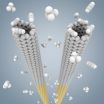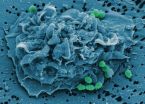SYDNEY, AUSTRALIA, November 16, 2012 (Press-News.org) In the Skill Session our seven rookies had to pick the correct line around a tricky course - the winner was the rider with the fastest lap time.
But even a lesson in slow manoeuvring couldn't stop eager Daniel putting pedal to the metal causing him to skid out just minutes into his ride.
"Makes me a bit nervous young Dan" Team Honda Racing Principal Paul Free said, watching on from the sideline.
One rider doing everything he could not to make a similar mistake was 17-year-old Brody from country New South Wales. Topping the leader board, Brody was acutely aware of what is up for grabs.
"It'd mean a lot to win this competition. I think it'd be a massive confidence boost. Obviously $20,000 is a lot of money. But the opportunity to do tests and everything with Honda, that'd be amazing," said Brody.
Although not at speed, this week's Points Challenge was vitally important - judges and mentors Paul Free and GP legend Daryl Beattie, both know there's more to being a successful superbike rider than just going fast.
But 17-year-old Kyle, one of the competitions youngest rookies, was struggling to focus on the task at hand - with a terrible bout of home sickness distracting him.
You know with Kyle, I'd like to see some aggression or some confidence come out and see him grow," said judge Daryl Beattie.
"I really like Kyle, he's just a lovely young fella you know. Just lacks confidence something fierce. He can ride a motorbike, there is no question there, it's almost like with Kyle when he puts the helmet on and puts the visor down, he's a different person," said judge Paul Free.
At the other end of the spectrum 21-year-old Glenn revealed the shocking reason he had to grow up fast.
"Yeah I lost both my parents to a motorcycle accident in 2003 when I was only 12...
But bad things happen to people every day and it's how that person deals with that problem and moves on from it to make them who they are," said Glenn.
With the Points Challenge complete and after a week of technical skills and tight corners, our oldest rider Sam received top marks. Once again pipped by the postie, Alex has had to settle for a three-way tie with Glenn and Brody for second. With this points update, Sam is now leading the pack on 10 points, and shy guy Kyle falls to last on just 6.
"InsureMyRide The Ultimate Rider" airs on Saturdays at 6pm and is jointly produced by WTFN and The Media Mix
All media inquiries and interview opportunities please contact:
ONE Publicist
Emma Davenport - ONE Publicist
03 9275 1124
edavenpo@networkten.com.au
or
WTFN Executive Producer
Steve Oemcke
03 9810 7100
InsureMyRide offers specialist online motorbike insurance, and when you insure online with IMR, you only pay for the insurance you need- not a call centre that you don't. So, whether you're into Road Bikes, Dirt Bikes or Scooters, we offer flexible insurance policies to meet your needs. InsureMyRide Pty Ltd is an authorised representative of Australian Alliance Insurance Company Ltd, the product issuer. Refer to the Product Disclosure Statement at www.insuremyride.com.au or by calling 13 24 53.
Skills Session Proves There's More to Being a Successful Superbike Rider
Last week on "InsureMyRide The Ultimate Rider" our contestants took it slow - easing themselves into the competition spirit. This week, the contestants were asked to step it up!
2012-11-16
ELSE PRESS RELEASES FROM THIS DATE:
Prompt Proofing Blog Post: Writing Tips: How to Write an Effective Blog
2012-11-16
We all know that a blog is essential for content marketing and SEO, yet some people are terrified at the idea and many more are unsure just where to start.
Remember that blog stands for web log - in other words, a diary or journal. Just as you would with a journal, you should write your blog from a personal perspective. Blog posts, by nature, are informal in tone; write as if you were talking to a friend, or at least chatting to a prospective client. You should write about topics you are passionate and knowledgeable about. Your passion will shine through your writing, ...
Calcium supplements remain a valuable tool for maintaining bone health
2012-11-15
WASHINGTON, D.C., November 14, 2012—Individuals who do not obtain recommended intake levels of calcium through dietary sources can safely utilize calcium supplements to achieve optimal bone health, an expert panel concludes. These findings appear in the November online edition of Advances in Nutrition, a journal that highlights the significance of recent research in nutrition and illustrates the central role of nutrition in the promotion of health and prevention of disease.
Responding to questions raised last year about a possible link between calcium supplements and ...
Transporting hypothermia victims to advanced heart and lung care facilities 'worth the trip'
2012-11-15
Hypothermia victims whose hearts have stopped functioning should be transported to a medical facility with advanced heart and lung support equipment, even if that means longer travel time, according to a new study by a University of British Columbia medical resident.
In a study published today in the New England Journal of Medicine, UBC medical resident Dr. Doug Brown and collaborators from Banff, Austria and Italy reviewed the medical literature and concluded that two aspects of the European approach to hypothermia rescue – rewarming and transport –should be adapted ...
'Cloning' could make structurally pure nanotubes for nanoelectronics
2012-11-15
Researchers from the University of Southern California (USC) and the National Institute of Standards and Technology (NIST) have demonstrated a technique for growing virtually pure samples of single-wall carbon nanotubes (SWCNTs) with identical structures, a process they liken to "cloning" the nanotubes.* If it can be suitably scaled up, their approach could solve an important materials problem in nanoelectronics: producing carbon nanotubes of a specific structure to order.
Single-wall carbon nanotubes are hollow cylinders of carbon atoms bound together in a hexagonal ...
NIST study suggests carbon nanotubes may protect DNA from oxidation
2012-11-15
Researchers at the National Institute of Standards and Technology (NIST) have provided evidence in the laboratory that single-wall carbon nanotubes (SWCNTs) may help protect DNA molecules from damage by oxidation. In nature, oxidation is a common chemical process in which a reactive chemical removes electrons from DNA and may increase the chance for mutations in cells. More studies are needed to see if the in vitro protective effect of nanotubes reported in the laboratory also occurs in vivo, that is, within a living organism.
"Our findings don't tell us whether carbon ...
Chronic fatigue syndrome -- a system under stress
2012-11-15
Australian researchers have discovered for the first time that reduced heart rate variability – or changes in heart beat timing – best predicts cognitive disturbances, such as concentration difficulties commonly reported by people with chronic fatigue syndrome (CFS). This adds to the growing body of evidence linking autonomic nervous system imbalance to symptoms of this poorly understood disorder.
The findings are reported in the journal PLOS ONE.
Chronic fatigue syndrome is characterised by medically unexplained, disabling fatigue and neuropsychiatric symptoms of ...
Flame retardants linked to neurodevelopmental delays in children
2012-11-15
Berkeley — Prenatal and childhood exposure to flame retardant compounds are linked to poorer attention, fine motor coordination and IQ in school-aged children, a finding by researchers at the University of California, Berkeley, that adds to growing health concerns over a chemical prevalent in U.S. households.
The new study, to be published in the Nov. 15 issue of the journal Environmental Health Perspectives, focuses on PBDEs, or polybrominated diphenyl ethers, a class of persistent, endocrine-disrupting compounds widely found in foam furniture, electronics, carpets, ...
At least one-third of marine species remain undescribed
2012-11-15
At least one-third of the species that inhabit the world's oceans may remain completely unknown to science. That's despite the fact that more species have been described in the last decade than in any previous one, according to a report published online on November 15 in the Cell Press publication Current Biology that details the first comprehensive register of marine species of the world—a massive collaborative undertaking by hundreds of experts around the globe.
The researchers estimate that the ocean may be home to as many as one million species in all—likely not more. ...
Surprising genetic link between kidney defects and neurodevelopmental disorders in kids
2012-11-15
New York, NY (November 15, 2012) — About 10 percent of kids born with kidney defects have large alterations in their genomes known to be linked with neurodevelopmental delay and mental illness, a new study by Columbia University Medical Center (CUMC) researchers has shown.
The study was published today in the online edition of the American Journal of Human Genetics.
Congenital defects of the kidney and urinary tract account for nearly 25 percent of all birth defects in the US and are present in about 1 in every 200 births. Eventually, an evaluation for genomic alterations ...
Appetite suppressant for scavenger cells
2012-11-15
This press release is available in German.
When infected with influenza, the body becomes an easy target for bacteria. The flu virus alters the host's immune system and compromises its capacity to effectively fight off bacterial infections. Now, a team of immunologists at the Helmholtz Centre for Infection Research (HZI) and cooperation partners has discovered that an immune system molecule called TLR7 is partly to blame. The molecule recognizes the viral genome – and then signals scavenger cells of the immune system to ingest fewer bacteria. The researchers published ...
LAST 30 PRESS RELEASES:
Injectable breast ‘implant’ offers alternative to traditional surgeries
Neuroscientists devise formulas to measure multilingualism
New prostate cancer trial seeks to reduce toxicity without sacrificing efficacy
Geometry shapes life
A CRISPR screen reveals many previously unrecognized genes required for brain development and a new neurodevelopmental disorder
Hot flush treatment has anti-breast cancer activity, study finds
Securing AI systems against growing cybersecurity threats
Longest observation of an active solar region
Why nail-biting, procrastination and other self-sabotaging behaviors are rooted in survival instincts
Regional variations in mechanical properties of porcine leptomeninges
Artificial empathy in therapy and healthcare: advancements in interpersonal interaction technologies
Why some brains switch gears more efficiently than others
UVA’s Jundong Li wins ICDM’S 2025 Tao Li Award for data mining, machine learning
UVA’s low-power, high-performance computer power player Mircea Stan earns National Academy of Inventors fellowship
Not playing by the rules: USU researcher explores filamentous algae dynamics in rivers
Do our body clocks influence our risk of dementia?
Anthropologists offer new evidence of bipedalism in long-debated fossil discovery
Safer receipt paper from wood
Dosage-sensitive genes suggest no whole-genome duplications in ancestral angiosperm
First ancient human herpesvirus genomes document their deep history with humans
Why Some Bacteria Survive Antibiotics and How to Stop Them - New study reveals that bacteria can survive antibiotic treatment through two fundamentally different “shutdown modes”
UCLA study links scar healing to dangerous placenta condition
CHANGE-seq-BE finds off-target changes in the genome from base editors
The Journal of Nuclear Medicine Ahead-of-Print Tip Sheet: January 2, 2026
Delayed or absent first dose of measles, mumps, and rubella vaccination
Trends in US preterm birth rates by household income and race and ethnicity
Study identifies potential biomarker linked to progression and brain inflammation in multiple sclerosis
Many mothers in Norway do not show up for postnatal check-ups
Researchers want to find out why quick clay is so unstable
Superradiant spins show teamwork at the quantum scale
[Press-News.org] Skills Session Proves There's More to Being a Successful Superbike RiderLast week on "InsureMyRide The Ultimate Rider" our contestants took it slow - easing themselves into the competition spirit. This week, the contestants were asked to step it up!



